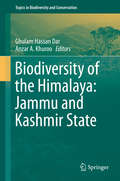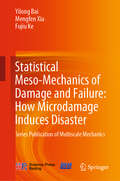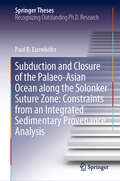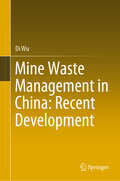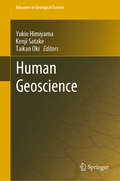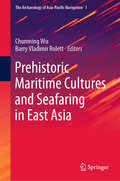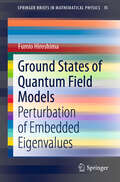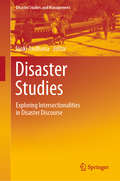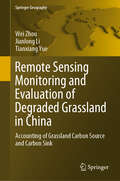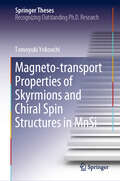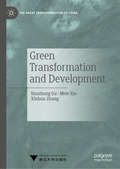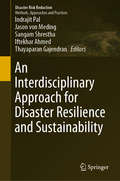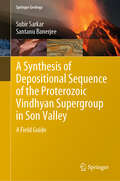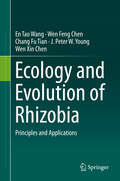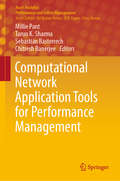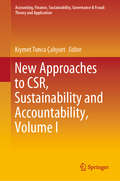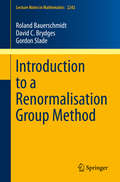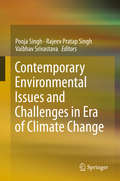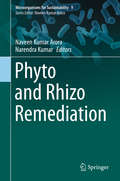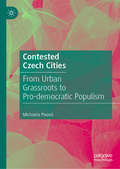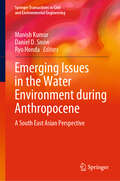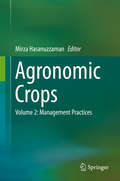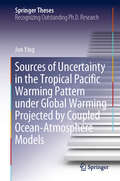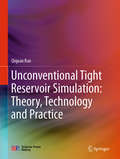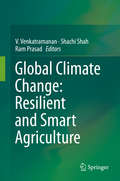- Table View
- List View
Biodiversity of the Himalaya: Jammu and Kashmir State (Topics in Biodiversity and Conservation #18)
by Ghulam Hassan Dar Anzar A. KhurooThe Himalaya, a global biodiversity hotspot, sustains about one-fifth of the humankind. Nestled within the north-western mountain ranges of the Himalaya, the Jammu and Kashmir (J&K) State harbours more than half of the biodiversity found in the Indian Himalaya. The wide expanse of State, spread across the subtropical Jammu, through the temperate Kashmir valley, to the cold arid Ladakh, is typical representative of the extensive elevational and topographical diversity encountered in the entire Himalaya.This book, the most comprehensive and updated synthesis ever made available on biodiversity of the J&K State, is a valuable addition to the biodiversity literature with global and regional relevance. The book, arranged into 7 parts, comprises of 42 chapters contributed by 87 researchers, each of whom is an expert in his/her own field of research. The precious baseline data contained in the book would form the foundation for assessing current status of knowledge about the bioresources, identify the knowledge gaps, and help prioritization of conservation strategies to steer the sustainable use of biodiversity in this Himalayan region. Given the breadth of topics covered under the banner of biodiversity in this book, it can surely serve as a model for documentation of biodiversity in other regions of the world. The book will be of immense value to all those who, directly or indirectly, have to deal with biodiversity, including students, teachers, researchers, naturalists, environmentalists, resource managers, planners, government agencies, NGOs and the general public at large.
Statistical Meso-Mechanics of Damage and Failure: Series Publication of Multiscale Mechanics
by Yilong Bai Mengfen Xia Fujiu KeThis book introduces a trans-scale framework necessary for the physical understanding of breakdown behaviors and presents some new paradigm to clarify the mechanisms underlying the trans-scale processes. The book, which is based on the interaction of mechanics and statistical physics, will help to deepen the understanding of how microdamage induces disaster and benefit the forecasting of the occurrence of catastrophic rupture. It offers notes and problems in each part as interesting background and illustrative exercises.Readers of the book would be graduate students, researchers, engineers working on civil, mechanical and geo-engineering, etc. However, people with various background but interested in disaster reduction and forecasting, like applied physics, geophysics, seismology, etc., may also be interested in the book.
Subduction and Closure of the Palaeo-Asian Ocean along the Solonker Suture Zone: Constraints from an Integrated Sedimentary Provenance Analysis (Springer Theses)
by Paul R. EizenhöferThis Ph.D. thesis attempts to decipher the closure of the Palaeozoic Palaeo-Asian Ocean along the enigmatic Solonker Suture in East Asia adopting a methodology that integrates geochemical and geochronological data from Palaeozoic sedimentary and volcanic rocks in the region. It provides an in-detail but also broad insight into the Palaeozoic to early Mesozoic tectonic evolution of the region, not only pin-pointing the debated location of the Solonker Suture but also the timing of final disappearance of the Palaeo-Asian Ocean during Permian to Early Triassic times. The results have led to propose a tectonic ‘soft-collision’ model for the amalgamation of the North China Craton and the Mongolian Terranes in northern Asia explaining the general absence of geologic features characteristic for continent-continent collisions such as the occurrence of regional-scale high-grade metamorphic rocks, ophiolite belts and fold-thrust structures. This new model may serve as a blueprint for the tectonic evolution of similar suture zones that are characterized by the absence of typical collision related lithologies and structures. The thesis is particularly useful as a guide for researchers who seek an in-depth understanding of the Palaeozoic to early Mesozoic tectonic evolution of northern China and Central Asia along the Solonker Suture.
Mine Waste Management in China: Recent Development
by Di WuThis book introduces recent development of technologies for mine waste management in China. For hard rock mines, the main mine wastes are tailings, and the tailings can be disposed above-ground and/or underground. The technology of consolidated tailings stockpile (CTS) that disposes tailings above-ground is introduced, and the application of this technology is also demonstrated. Besides, the technology of cemented tailings (or paste) backfill (CTB or CPB) which deals with tailings underground is also discussed. The properties of CTB materials and the utilization of CTB technology are described and analyzed. For coal mines, the main mine wastes are coal gangue and fly ash. The technology of cemented coal gangue-fly ash backfill (CGFB) that manages coal mine waste underground is presented. The THMC coupling properties of CGFB materials are investigated, which can contribute to a better design of stable, durable and environmentally friendly CGFB mixtures. The application of CGFB technology in a coal mine is also presented. This book, which systematically reviews and discusses the development of mine waste management technologies in China, is expected to provide readers comprehensive information about mine waste management.
Human Geoscience (Advances in Geological Science)
by Yukio Himiyama Kenji Satake Taikan OkiThis book is a product of the joint efforts of interdisciplinary academic fields under the integrative framework of human geoscience. Human geoscience is a new genre of geoscience concerned with the natural phenomena that occur on the surface of the Earth and their relations with human activities. It therefore has connections with many fields of geoscience, namely, physical geography, geomorphology, geology, soil science, sedimentology, seismology, volcanology, meteorology, climatology, oceanography, and hydrology. It also has strong links to the humanities, social sciences, agricultural sciences, and engineering related to disaster prevention or mitigation. All these disciplines are important fields for understanding disasters and global environmental problems and for evaluating the associated risks comprehensively, then proposing mitigation strategies.The volume is designed for those who may not necessarily have a geoscience background but have broad scientific interest in understanding the causes, mechanisms, and consequences of geo-disasters and global environmental problems and wish to make the world more sustainable on that basis. The book consists of six parts: I. Introduction, II. Earth Surface Realms, III. Natural Resources and Society, IV. Natural Hazards and Society, V. Global Environmental Problems, and VI. Global Sustainability Programmes and Human Geoscience, which discusses the contribution of this field of science to a new comprehensive framework for global sustainability.
Prehistoric Maritime Cultures and Seafaring in East Asia (The Archaeology of Asia-Pacific Navigation #1)
by Chunming Wu Barry Vladimir RolettThis book focuses on prehistoric East Asian maritime cultures that pre-dated the Maritime Silk Road, the "Four Seas" and "Four Oceans" navigation system recorded in historical documents of ancient China. Origins of the Maritime Silk Road can be traced to prosperous Neolithic and Metal Age maritime-oriented cultures dispersed along the coastlines of prehistoric China and Southeast Asia.The topics explored here include Neolithisation and the development of prehistoric maritime cultures during the Neolithic and early Metal Age; the expansion and interaction of these cultures along coastlines and across straits; the "two-layer" hypothesis for explaining genetic and cultural diversity in south China and Southeast Asia; prehistoric seafaring and early sea routes; the paleogeography and vegetation history of coastal regions; Neolithic maritime livelihoods based on hunting/fishing/foraging adaptations; rice and millet cultivation and their dispersal along the coast and across the open sea; and interaction between farmers and maritime-oriented hunter/fisher/foragers. In addition, a series of case studies enhances understanding of the development of prehistoric navigation and the origin of the Maritime Silk Road in the Asia-Pacific region.
Ground States of Quantum Field Models: Perturbation of Embedded Eigenvalues (SpringerBriefs in Mathematical Physics #35)
by Fumio HiroshimaThis book provides self-contained proofs of the existence of ground states of several interaction models in quantum field theory. Interaction models discussed here include the spin-boson model, the Nelson model with and without an ultraviolet cutoff, and the Pauli–Fierz model with and without dipole approximation in non-relativistic quantum electrodynamics. These models describe interactions between bose fields and quantum mechanical matters.A ground state is defined as the eigenvector associated with the bottom of the spectrum of a self-adjoint operator describing the Hamiltonian of a model. The bottom of the spectrum is however embedded in the continuum and then it is non-trivial to show the existence of ground states in non-perturbative ways. We show the existence of the ground state of the Pauli–Fierz mode, the Nelson model, and the spin-boson model, and several kinds of proofs of the existence of ground states are explicitly provided. Key ingredients are compact sets and compact operators in Hilbert spaces. For the Nelson model with an ultraviolet cutoff and the Pauli–Fierz model with dipole approximation we show not only the existence of ground states but also enhanced binding. The enhanced binding means that a system for zero-coupling has no ground state but it has a ground state after turning on an interaction.The book will be of interest to graduate students of mathematics as well as to students of the natural sciences who want to learn quantum field theory from a mathematical point of view. It begins with abstract compactness arguments in Hilbert spaces and definitions of fundamental facts of quantum field theory: boson Fock spaces, creation operators, annihilation operators, and second quantization. This book quickly takes the reader to a level where a wider-than-usual range of quantum field theory can be appreciated, and self-contained proofs of the existence of ground states and enhanced binding are presented.
Disaster Studies: Exploring Intersectionalities in Disaster Discourse (Disaster Studies and Management)
by Janki AndhariaThis book covers several dimensions of disaster studies as an emerging discipline. It is the inaugural book in the series ‘Disaster Studies and Management’ and deals with questions such as “Is disaster management a field of practice, a profession, or simply a new area of study?” Exploring intersectionalities, the book also examines areas of research that could help enhance the discourse on disaster management from policy and practice perspectives, revisiting conventional event-centric approaches, which are the basis for most writings on the subject. Several case studies and comparative analyses reflect a critical reading of research and practice concerning disasters and their management. The book offers valuable insights into various subjects including the challenge of establishing inter- and multi-disciplinary teams within the academia involved in disaster studies, and sociological and anthropological readings of post-disaster memoryscapes. Each of the contributors has an enduring interest in disaster studies, thus enriching the book immensely. This book will be of interest to all the students and scholars of disaster studies and disaster management, as well as to practitioners and policymakers.
Remote Sensing Monitoring and Evaluation of Degraded Grassland in China: Accounting of Grassland Carbon Source and Carbon Sink (Springer Geography)
by Wei Zhou Jianlong Li Tianxiang YueThis book focuses on grassland ecosystem evaluation including vegetation coverage, net primary productivity, carbon sink accounting, and grassland degradation evaluation based on mutual data resource, ecosystem model simulation, remote sensing monitoring and driving mechanism exploration. It aims to provide a guide seeking to understand the overall situation of grassland in China in the context of global climate change and build a scenario for the driving force quantitative evaluation. It will be an essential reference to the terrestrial ecosystem carbon cycle and degraded grassland ecological restoration engineer implementation. Chapters are carefully developed to cover (1) situation of grassland in China; (2) spatial-temporal of grassland coverage in China;(3) net primary productivity evaluation; (4) carbon sink/source accounting and its carbon-hydrology effect;(5) grassland landscape pattern; (6) grassland degradation evaluation based on remote sensing;(7) Grassland degradation restoration and constructing green ecological protective screen. The new scenario and driving mechanism evaluation model make this book a valuable read for researcher of land ecosystem carbon cycle, ecosytem degradation remote sensing evaluation as well as organizations engaged in eco-restoration practices.
Magneto-transport Properties of Skyrmions and Chiral Spin Structures in MnSi (Springer Theses)
by Tomoyuki YokouchiThis book provides extensive and novel insights into transport phenomena in MnSi, paving the way for applying the topology and chirality of spin textures to the development of spintronics devices. In particular, it describes in detail the key measurements, e.g. magnetoresistance and nonlinear electronic transport, and multiple material-fabrication techniques based on molecular beam epitaxy, ion-beam microfabrication and micromagnetic simulation. The book also reviews key aspects of B20-type MnSi chiral magnets, which host magnetic skyrmions, nanoscale objects formed by helical spatial spin structures. Readers are then introduced to cutting-edge findings on the material. Furthermore, by reviewing the author’s successful experiments, the book provides readers with a valuable update on the latest achievements in the measurement and fabrication of magnetic materials in spintronics.
Green Transformation and Development (The Great Transformation of China)
by Shuzhong Gu Meie Xie Xinhua ZhangThis book offers an insiders' view into Chinese plans for a green transformation of the economy of China. Analyzing the pressures, drive, and resistance to this green transformation in China, the book explores the key fields, from green finance and green banking to green consumption and green urbanization. Furthermore, it offers a guide on how government officials will be penalized or rewarded for their successful furtherance of green objectives. This book will be of interest to climate activists, China watchers, architects, and all those invested in a sustainable future.
An Interdisciplinary Approach for Disaster Resilience and Sustainability (Disaster Risk Reduction)
by Indrajit Pal Jason Von Meding Sangam Shrestha Iftekhar Ahmed Thayaparan GajendranThis book includes selected papers presented at the international expert forum on “Mainstreaming Resilience and Disaster Risk Reduction in Education,” held at the Asian Institute of Technology, Thailand on 1–2 December 2017. The journey towards disaster risk reduction and resilience requires the participation of a wide array of stakeholders ranging from academics to policymakers, to disaster managers. Given the multifaceted and interdependent nature of disasters, disaster risk reduction and resilience require a multidisciplinary problem-solving approach and evidence-based techniques from the natural, social, engineering, and other relevant sciences.Traditionally, hazard and disaster-related studies have been dominated by the engineering and social science fields. In this regard, the main purpose of this book is to capture the multidisciplinary and multisectoral nature of disaster risk reduction, and to gather existing data, research, conceptual work, and practical cases regarding risk reduction and its ties to sustainable development under a single “umbrella.” Along with the sustainability aspect, the book also links disaster risk reduction with development, technology, governance, education, and climate change, and includes discussions on challenges, solutions, and best practices in the mainstreaming of disaster risk reduction.
A Synthesis of Depositional Sequence of the Proterozoic Vindhyan Supergroup in Son Valley: A Field Guide (Springer Geology)
by Subir Sarkar Santanu BanerjeeThis book offers extensive information on the course of sedimentation in the Proterozoic Vindhyan Basin and the potential record of ancient life stored within the rocks. It covers topics ranging from facies analysis to sequence-building, from carbonates to siliciclastics, and mixed lithology and life records from microbial to potentially eukaryotes, along with the basin evolutionary history. Further, the book includes 75 color photographs and accompanying hand-sketches to help readers grasp key aspects of Vindhyan Geology. Vindhyan rocks are well known for their excellent preservation of microbial record of earth. Offering a student-friendly field guide containing detailed route maps, geological maps and a wealth of visual examples, it is also extremely useful in terms of understanding the microbe-dominated environments on Mars.
Ecology and Evolution of Rhizobia: Principles and Applications
by En Tao Wang Chang Fu Tian Wen Feng Chen J. Peter Young Wen Xin ChenThis book reviews the history and development of rhizobial ecology (diversity, function and interactions with the biotic and abiotic environments), evolution (genome diversification, systematics of symbiotic genes) and application. Further, it describes the new concept of rhizobia, the latest systematic methods, biogeographic study methods, and genomic studies to identify the interactions between rhizobia, legumes and environments. To enable readers to gain a comprehensive understanding of rhizobial biogeography, the book provides effective protocols for the selection and application of high-efficiency rhizobial inoculants. In addition, it presents standard and modern methods used in studies on rhizobial ecology and evolution in dedicated appendices, making it a unique and valuable handbook for researchers.
Computational Network Application Tools for Performance Management (Asset Analytics)
by Millie Pant Tarun K. Sharma Sebastián Basterrech Chitresh BanerjeeThis book explores a range of important theoretical and practical issues in the field of computational network application tools, while also presenting the latest advances and innovations using intelligent technology approaches. The main focus is on detecting and diagnosing complex application performance problems so that an optimal and expected level of system service can be attained and maintained. The book discusses challenging issues like enhancing system efficiency, performance, and assurance management, and blends the concept of system modeling and optimization techniques with soft computing, neural network, and sensor network approaches. In addition, it presents certain metrics and measurements that can be translated into business value. These metrics and measurements can also help to establish an empirical performance baseline for various applications, which can be used to identify changes in system performance. By presenting various intelligent technologies, the book provides readers with compact but insightful information on several broad and rapidly growing areas in the computation network application domain.The book’s twenty-two chapters examine and address current and future research topics in areas like neural networks, soft computing, nature-inspired computing, fuzzy logic and evolutionary computation, machine learning, smart security, and wireless networking, and cover a wide range of applications from pattern recognition and system modeling, to intelligent control problems and biomedical applications. The book was written to serve a broad readership, including engineers, computer scientists, management professionals, and mathematicians interested in studying tools and techniques for computational intelligence and applications for performance analysis. Featuring theoretical concepts and best practices in computational network applications, it will also be helpful for researchers, graduate and undergraduate students with an interest in the fields of soft computing, neural networks, machine learning, sensor networks, smart security, etc.
New Approaches to CSR, Sustainability and Accountability, Volume I (Accounting, Finance, Sustainability, Governance & Fraud: Theory and Application)
by Kıymet Tunca ÇalıyurtThis book provides a platform for discussing the challenges that organizations face in order to implement sustainability, ethics, and effective corporate governance, all of which are important elements of “standing out” from other companies. Examining the background of the New European Consensus on development with the new guiding motto ‘Our World, Our Dignity, Our Future’, the authors explore how this new legislation on sustainability issues around the world is forcing companies to deal directly with sustainability issues. The 2030 Agenda for Sustainable Development (2030 Agenda), adopted by the United Nations in September 2015, is the international community’s response to global challenges and trends in connection with sustainable development. With the Sustainable Development Goals (SDGs) at its core, the 2030 Agenda is a transformative political framework designed to eradicate poverty and achieve sustainable development globally. It balances the economic, social and environmental dimensions of sustainable development, including the key issues of governance and peaceful and inclusive societies, and recognizes the essential interlinkages between its goals and targets, i.e., that they must be implemented as a whole and not selectively. The respective chapters in this volume raise a number of questions regarding companies’ ability to implement sustainability, ethics, and effective corporate governance. Simultaneously, they explore how organizations must adapt to sustainability-related developments.
Introduction to a Renormalisation Group Method (Lecture Notes in Mathematics #2242)
by Roland Bauerschmidt David C. Brydges Gordon SladeThis is a primer on a mathematically rigorous renormalisation group theory, presenting mathematical techniques fundamental to renormalisation group analysis such as Gaussian integration, perturbative renormalisation and the stable manifold theorem. It also provides an overview of fundamental models in statistical mechanics with critical behaviour, including the Ising and φ4 models and the self-avoiding walk. The book begins with critical behaviour and its basic discussion in statistical mechanics models, and subsequently explores perturbative and non-perturbative analysis in the renormalisation group. Lastly it discusses the relation of these topics to the self-avoiding walk and supersymmetry. Including exercises in each chapter to help readers deepen their understanding, it is a valuable resource for mathematicians and mathematical physicists wanting to learn renormalisation group theory.
Contemporary Environmental Issues and Challenges in Era of Climate Change
by Pooja Singh Rajeev Pratap Singh Vaibhav SrivastavaOver the last few decades, unprecedented global population growth has led to increased demand for food and shelter. At the same time, extraction of natural resources beyond the Earth’s resilience capacity has had a devastating effect on ecosystems and environmental health. Furthermore, climate change is having a significant impact in a number of areas, including the global hydrological cycle, ecosystem functioning, coastal vulnerability, forest ecology, food security, and agricultural sustainability. According to the Intergovernmental Panel on Climate Change (IPCC), only immediate and sustained action will prevent climate change causing irreversible and potentially catastrophic damage to our environment. This book presents various scientific views and concepts, research, reviews, and case studies on contemporary environmental issues in changing climate scenarios and highlights different adaptation measures. Increasing awareness of modern-day patterns of climate change, it addresses questions often raised by environmental scientists, researchers, policymakers and general readers.
Phyto and Rhizo Remediation (Microorganisms for Sustainability #9)
by Naveen Kumar Arora Narendra KumarThe increasing human population and the associated activities have negatively influenced the ecosystems and life on earth. The continuous addition of agrochemicals, heavy metals and industrial wastes/ effluents in the ecosystems have caused great harm, including loss of productivity, biodiversity, climate change and diseases in plants, animals and humans, resulting in increased marginal lands and endangered sustainability of life on earth. Hence, there is an urgent need to reverse the impact of dangerous pollutants through a holistic, sustainable and biotic approach. Bioremediation involves the utilization of biological systems, mainly plants (phytoremediation) or microorganisms or both in combination (rhizoremediation) for the removal or degradation of pollutants and revive the habitats in an eco-friendly manner. Recently, there have been many success stories related to bioremediation involving plants or plant-microbe interactions. These success stories are related to the removal of heavy metals, pesticides, polyaromatic hydrocarbons, explosives, radionuclides or reduction of biological oxygen demand, total dissolved solids, total suspended solids, oil spills in water bodies. Rhizoremediation has also been successfully used for reclamation of saline or marginal soils. With the range of pollutants and the total area (on earth) covered by these toxic chemicals, it is important that these eco-friendly technologies be utilized in a better way. The book throws light on the recent happenings, research and success stories related to bioremediation of polluted habitats through phytoremediation or rhizoremediation. The book also highlights some of the significantly important plant and microbial species involved in remediation, the physiology, biochemistry and the mechanisms of remediation by various plants and microbes, and suggestions for future improvement of bioremediation technology.
Contested Czech Cities: From Urban Grassroots to Pro-democratic Populism
by Michaela PixováThis book focuses on urban grassroots movements in post-socialist Czechia and their struggle against unprofessional and nondemocratic urban processes in their cities. It shows that in the context of neoliberal urban restructuring, weakly consolidated democracy, and corporate capture of the local state, urban activists often resort to entering electoral competition as the only efficient way of improving the situation in their cities. The book is based on four case studies from different Czech cities, narrating stories of activists struggling against a controversial flood protection project, the demolition of public buildings, an unhealthy land-use plan, arrogant development, and overpriced city halls. It offers valuable insight into the obstacles created by institutionalized forms of power abuse which urban activists must deal with and discusses the pro-democratic potential of urban grassroot movements’ efforts to overcome their limited ability to influence political processes via standard means of civic engagement and protest activities.
Emerging Issues in the Water Environment during Anthropocene: A South East Asian Perspective (Springer Transactions in Civil and Environmental Engineering)
by Manish Kumar Daniel D. Snow Ryo HondaThis book intends to bring together and integrate the subject matter of water quality. The book covers aspects of water related to climate change, emerging aspects of engineering sciences, bio-geochemical sciences, hydro geochemistry, river management and morphology, social sciences, and public policy. The book covers the role of disruptive innovations in water management, policy formation and impact mitigation strategies. The book includes lab results as well as case studies. It provides recommendations and solutions for policy making and sustainable water management. The chapters in this book deal cohesively with many aspects of the water environment during the Anthropocene era. The contents cover myriad issues, such as land degradation, water scarcity, urbanization, climate change, and disruptive innovation. The book also discusses issues highly pertinent to society and sustainability, such as the prevalence of enteric viruses and pharmaceutical residues as a possible anthropogenic markers in the aquatic environment. The book will prove useful for students, professionals, and researchers working on various aspects of water related concerns.
Agronomic Crops: Volume 2: Management Practices
by Mirza HasanuzzamanAgronomic crops have provided food, beverages, fodder, fuel, medicine and industrial raw materials since the beginning of human civilization. More recently, agronomic crops have been cultivated using scientific rather than traditional methods. However, in the current era of climate change, agronomic crops are suffering from different environmental stresses that result in substantial yield loss. To meet the food demands of the ever-increasing global population, new technologies and management practices are being adopted to boost yields and maintain productivity under both normal and adverse conditions. Further, in the context of sustainable agronomic crop production, scientists are adopting new approaches, such as varietal development, soil management, nutrient and water management, and pest management. Researchers have also made remarkable advances in developing stress tolerance in crops. However, the search for appropriate solutions for optimal production to meet the increasing food demand is still ongoing. Although there are several publications on the recent advances in these areas, there are few comprehensive resources available covering all of the recent topics. This timely book examines all aspects of production technologies, management practices and stress tolerance of agronomic crops.
Sources of Uncertainty in the Tropical Pacific Warming Pattern under Global Warming Projected by Coupled Ocean-Atmosphere Models (Springer Theses)
by Jun YingThis book discusses the sources of uncertainty in future model projections of the tropical Pacific SST warming pattern under global warming. It mainly focuses on cloud radiation feedback and ocean dynamical effect, which reveal to be the two greatest sources of uncertainty in the tropical Pacific SST warming pattern. Moreover, the book presents a correction for model projections of the tropical Pacific SST warming pattern based on the concept of “observational constraints”; the corrected projection exhibits a more El Niño-like warming pattern.
Unconventional Tight Reservoir Simulation: Theory, Technology and Practice
by Qiquan RanThis book systematically introduces readers to the simulation theory and techniques of multiple media for unconventional tight reservoirs. It summarizes the macro/microscopic heterogeneities; the features of multiscale multiple media; the characteristics of complex fluid properties; the occurrence state of continental tight oil and gas reservoirs in China; and the complex flow characteristics and coupled production mechanism under unconventional development patterns. It also discusses the simulation theory of multiple media for unconventional tight oil and gas reservoirs; mathematic model of flow through discontinuous multiple media; geological modeling of discrete multiscale multiple media; and the simulation of multiscale, multiphase flow regimes and multiple media. In addition to the practical application of simulation and software for unconventional tight oil and gas, it also explores the development trends and prospects of simulation technology. The book is of interest to scientific researchers and technicians engaged in the development of oil and gas reservoirs, and serves as a reference resource for advanced graduate students in fields related to petroleum.
Global Climate Change: Resilient and Smart Agriculture
by V. Venkatramanan Shachi Shah Ram PrasadThis book provides essential insights into methods and practices of ‘Climate-smart Agriculture,’ which is driven by the principles of climate resilience and smart resource use in agricultural production. Climate-smart agriculture is a key policy instrument for achieving poverty eradication and a hunger-free world, as well as mitigating the effects of climate change. This book discusses in detail climate-smart agricultural technologies and practices that can reduce the vulnerability of agricultural systems, improve the livelihoods of farmers and other stakeholders, and reduce the greenhouse gas emissions from crop production and livestock husbandry. The agriculture, forestry and other land use (AFOLU) sector produces roughly 10–12 gigatons of CO2-equivalent per year; therefore, sustainable practices for agriculture and related land use hold immense potential to mitigate climate change. The potential impacts of climate variability and climate change on agriculture are extensively documented and articulated, especially with regard to global and national environmental agendas that call for innovation, transformation and climate-resilient advances in agriculture. As the book demonstrates, climate-smart agriculture offers an excellent tool for boosting agricultural output to feed the growing global population; for reducing greenhouse gases emissions from agriculture and other land use; and for protecting agricultural production systems from the impending dangers of climate change.
